MONDAY MACRO: This turnover ratio has declined to 10-year lows… are local investors holding the market up?

National government debt isn’t necessarily a bad thing—in fact, governments normally borrow to revitalize or speed up domestic economic activity. However, the Philippines’ outstanding national debt almost hit the PHP 13 trillion mark in April 2022, which has some investors spooked.
To gauge the confidence level of foreign investors in the Philippine market, we look into the iShares MSCI Philippines ETF (EPHE) and Philippine Stock Exchange All Shares.
Philippine Markets Newsletter:
The Monday Macro Report
Powered by Valens Research
The Philippines currently faces several economic challenges such as rising inflation and debt. In one of our recent articles, we talked about the first interest rate hike in over 18 months to control the soaring inflation that is forecasted to further increase in the coming months.
In addition, foreign investors are also weighing higher commodity prices as a point against investing in the Philippines as the country is a net energy importer. The country is also facing an increasing risk of a valuation derating given all of these issues.
With these challenges, the country will need the help of foreign investors to address the continuously growing outstanding debt as it recovers from the pandemic. We look to gauge the attractiveness of the Philippine market in the eyes of foreign investors.
The iShares MSCI Philippines ETF (EPHE) is an exchange-traded fund that focuses on investing in the Philippines’ publicly listed companies.
On the other hand, the Philippine Stock Exchange All Shares Index (PSAL) is a stock index in the Philippine Stock Exchange (PSE) composed of the common stocks of all companies listed on the PSE Main Board.
The EPHE turnover measures the frequency that these assets are being traded. Meanwhile, the PSAL closing price is the aggregate last trading price during the trading day.

Movements in the EPHE turnover show that from lower levels, it increased exponentially in 2017 before gradually decreasing from 2018 to 2019. During most of the pandemic, it managed to remain at 10-year highs, though since the start of 2022, turnover has fallen to 10-year lows.
It appears foreign investors may be concerned about the outlook and current situation of the Philippine economy, as shown by the lower trading activity.
The PSAL closing price, on the other hand, shows less volatility. While maintaining price stability from 2014 to 2019, it significantly declined, as expected, during the first few months of the pandemic.
What this chart suggests is with the low EPHE turnover and the relatively stable PSAL closing price, it appears that prices in the Philippine stock market now are dictated more by local players than by foreign investors.
While the recent lows in EPHE turnover are similar to those of 2014-2016, the economic environment then was different. Unlike the recent inflation rate of 4.9% recorded at the end of April 2022, inflation fell from 4.2% in August 2014 to a low of -0.4% in September 2015 suggesting deflation at the time.
In addition, GDP growth was between 0.8% to 2% from mid-2014 to mid-2016, similar to the 1.9% recorded for the first quarter of 2022. Unlike inflation, GDP growth appears to be more in line with EPHE turnover for the period.
Adding the incoming shift in the administration, foreign investors will continue to monitor the current situation in the country. More importantly, their decisions will likely be based on how the pressing economic issues will be addressed.
About the Philippine Markets Newsletter
“The Monday Macro Report”
When just about anyone can post just about anything online, it gets increasingly difficult for an individual investor to sift through the plethora of information available.
Investors need a tool that will help them cut through any biased or misleading information and dive straight into reliable and useful data.
Every Monday, we publish an interesting chart on the Philippine economy and stock market. We highlight data that investors would normally look at, but through the lens of Uniform Accounting, a powerful tool that gets investors closer to understanding the economic reality of firms.
Understanding what kind of market we are in, what leading indicators we should be looking at, and what market expectations are, will make investing a less monumental task than finding a needle in a haystack.
Hope you’ve found this week’s macro chart interesting and insightful.
Stay tuned for next week’s Monday Macro report!
Regards,
Angelica Lim
Research Director
Philippine Markets Newsletter
Powered by Valens Research
www.valens-research.com




